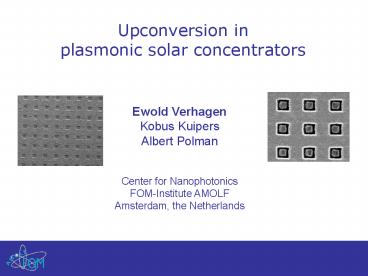Upconversion in plasmonic solar concentrators - PowerPoint PPT Presentation
1 / 25
Title: Upconversion in plasmonic solar concentrators
1
Upconversion inplasmonic solar concentrators
Ewold Verhagen Kobus Kuipers Albert
Polman Center for Nanophotonics FOM-Institute
AMOLF Amsterdam, the Netherlands
2
Infrared light is not absorbed in solar cell
Si solar cell bandgap 1100 nm 18 of power not
absorbed
3
Solution upconversion
Model system erbium Two excited Er
ions exchange energy 2 IR photons ? 1 VIS photon
Er absorption
4
Er-doped upconversion lasers, amplifiers
Pumped at 1500 nm
With Vahala group, CALTECH
APL 68, 1886 (1996), JAP 79, 1258 (1996) Opt.
Lett. 21, 576 (1996), APL 84, 1037
(2004) submitted (2008)
5
Higher-order upconversion
Er-implanted Al2O3 film (2 at. Er)excitation
1480 nm
550 nm
660 nm
660
820 nm
980
980 nm
Er3 energy levels
550
820
(1480 nm)
6
Upconversion
550 nm
660 nm
Needed Concentration
980 nm
Er3 energy levels
(1480 nm)
7
Field concentration with surface plasmons
Surface plasmon polariton (SPP) evanescent
surface wave coupled to charge oscillations at
metal surface
H
kSPP gt k0
hundreds of nm
8
Field concentration with surface plasmons
- Surface plasmon polariton (SPP) evanescent
surface wave coupled to charge oscillations at
metal surface
H
kSPP gt k0
hundreds of nm
field concentration at tip
Verhagen et al., Nano Lett. 7, 334 (2007)
Verhagen et al., Opt. Express 16, 45 (2008)
9
Field concentration inside sub-? hole arrays
- Diffractive coupling on subwavelength hole array
wave vector matching
760 nm
(1,0) Au/Al2O3
4
0.6
light line
0.5
3
0.4
a
(eV)
Transmittance
2
0.3
wavevector mismatch
E
(1,1) Au/air
(1,0) Au/air
0.2
1
0
20
40
60
0.1
kSPP
(rad/µm)
0
600
800
1000
1200
1400
1600
Wavelength (nm)
10
Diffractive coupling to SPPs
- Diffractive coupling on subwavelength hole array
wave vector matching
On-resonance Field Concentration
(1,0) Au/Al2O3
760 nm
4
0.6
780 nm
light line
800 nm
0.5
810 nm
3
820 nm
0.4
a
830 nm
(eV)
Transmittance
840 nm
2
0.3
E
(1,1) Au/air
(1,0) Au/air
0.2
1
0
20
40
60
0.1
kSPP
(rad/µm)
0
600
800
1000
1200
1400
1600
Wavelength (nm)
excitation wavelength
11
Upconversion enhancement in hole arrays
UC enhancement IUC,hole array / IUC,reference
?exc 1480 nm
Iexc 200 W/cm2
period810 nm
12
Upconversion depends on pitch and hole size
UC enhancement IUC,hole array / IUC,reference
?exc 1480 nm
Iexc 2 W/cm2
(1,1) SPP excitation
(1,0) SPP excitation
13
Upconversion depends on pitch and hole size
- Larger hole diameter
- Stronger coupling
- Smaller propagation length
- Optimum 0.3 d/p
?exc 1480 nm
Iexc 2 W/cm2
(1,1) SPP excitation
(1,0) SPP excitation
SPP
14
Diffractive coupling angle dependent
- Diffractive coupling on subwavelength hole array
wave vector matching
760 nm
(1,0) Au/Al2O3
0.6
Field concentration only for fixed
angle/frequency
0.5
0.4
a
Transmittance
0.3
(1,0) Au/air
(1,1) Au/air
0.2
0.1
0
600
800
1000
1200
1400
1600
Wavelength (nm)
15
Solution coaxial hole arrays
800 nm
Broad transmission peak in coaxial apertures due
to localized resonance
1
0.8
0.6
Transmittance
0.4
0.2
0
600
800
1000
1200
1400
1600
Wavelength (nm)
16
Localized resonances in coaxial apertures
- Localized resonance due to SPPs propagating
inside the coaxes, reflecting at the top/bottom - Field enhancement independent of angle
Field at position of Er ions, from FDTD
Cavity mode condition
36
E
kz
d
Enhancement of E2
800 nm
0
Cf Baida, van Labeke
17
Upconversion in coaxial hole arrays
980 nm upconversion enhanced 450-fold
Comparing different cavities (radius, gap width)
1
A
B
0.8
B
0.6
A
UC enhancement (980 nm)
Transmittance
C
radius
C
0.4
gap width
0.2
0
600
800
1000
1200
1400
1600
Wavelength (nm)
18
Coaxial hole arrays angle dependence
Comparing different cavities (radius, gap width)
No angle dependence for localized SPPs
1
A
0.8
B
0.6
Transmittance
radius
C
0.4
gap width
0.2
0
600
800
1000
1200
1400
1600
Wavelength (nm)
19
Conclusion
Strong upconversion in plasmonic
nanostructures 1500 nm ? 980 nm Hole arrays
diffractive coupling Coaxial hole arrays
localized modes Resonances tunable by
shape Intensity enhancement up to
50x Upconversion enhancements 450x (980 nm)
1200x (550 nm)
20
Outlook
- Erbium upconversion is model system
- Practical application requires sensitized
excitation or QDs, dyes - Novel solar cell designs
- - reduce active material volume (QDs, )
- - small dimension low carrier mobility OK
- Enhanced efficiency under gt 1 sun intensity
21
Upconversion enhancement in hole arrays
Field enhancement under array depends on
- Resonance detuning
- Hole tunneling
- Scattering efficiency of holes
- Resonance linewidth
?exc 1480 nm
Iexc 2 W/cm2
(period 810 nm)
(1,1) SPP excitation
hole diameter (d/p)
0.8
(1,0) SPP excitation
0.6
Transmittance
0.4
0.2
0
600
800
1000
1200
1400
1600
Wavelength (nm)
22
Power dependency of upconversion emission
23
Adiabatic transformation of plane wave
Plane wave can efficiently be concentrated in MIM
waveguides
FDTD Calculation
1 µm ? 40 nm
1-2 µm
Ag
2 µm ? 40 nm
40 nm
Field enhancement does not rely on resonance
large bandwidth and angular range
24
Near-field imaging of nanofocusing
Focusing of 1550 nm light to lt 300 nm
to detector
lexc 1550 nm
25
FDTD Simulations of final 8 µm of taper
xy plane
E2
z -35 nm
E2
n1 1
1 µm
excitation bound SPP mode at substrate side
n2 1.74
xz plane
- Nanofocusing predicted at 10 nm from tip 100 x
E2 enhancement - 3D Subwavelength confinement 1.5 µm light
focused to 92 nm
tip
start































